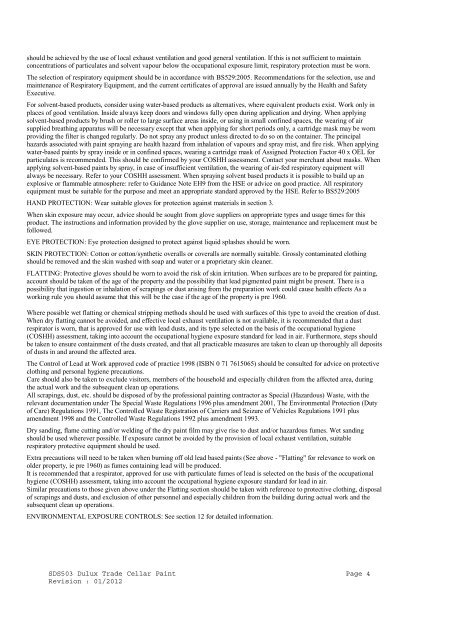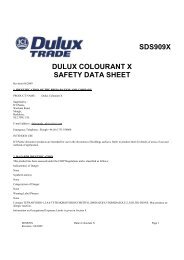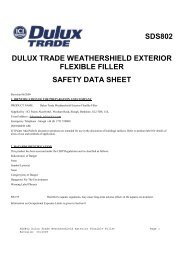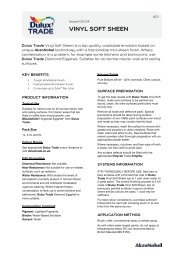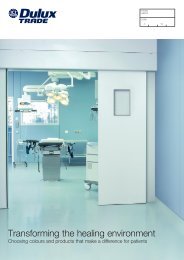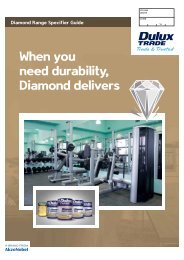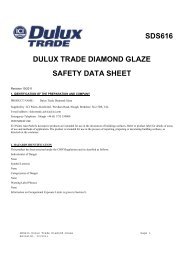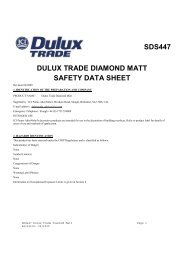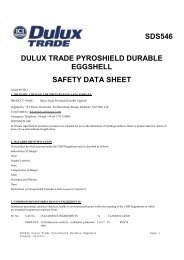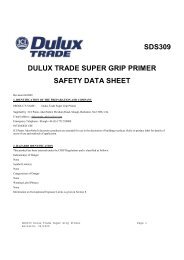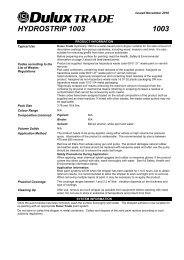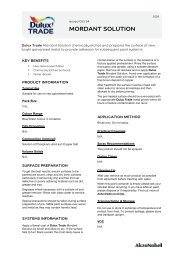Download PDF safety datasheet SDS503 for Dulux Trade Cellar Paint
Download PDF safety datasheet SDS503 for Dulux Trade Cellar Paint
Download PDF safety datasheet SDS503 for Dulux Trade Cellar Paint
You also want an ePaper? Increase the reach of your titles
YUMPU automatically turns print PDFs into web optimized ePapers that Google loves.
should be achieved by the use of local exhaust ventilation and good general ventilation. If this is not sufficient to maintainconcentrations of particulates and solvent vapour below the occupational exposure limit, respiratory protection must be worn.The selection of respiratory equipment should be in accordance with BS529:2005. Recommendations <strong>for</strong> the selection, use andmaintenance of Respiratory Equipment, and the current certificates of approval are issued annually by the Health and SafetyExecutive.For solvent-based products, consider using water-based products as alternatives, where equivalent products exist. Work only inplaces of good ventilation. Inside always keep doors and windows fully open during application and drying. When applyingsolvent-based products by brush or roller to large surface areas inside, or using in small confined spaces, the wearing of airsupplied breathing apparatus will be necessary except that when applying <strong>for</strong> short periods only, a cartridge mask may be wornproviding the filter is changed regularly. Do not spray any product unless directed to do so on the container. The principalhazards associated with paint spraying are health hazard from inhalation of vapours and spray mist, and fire risk. When applyingwater-based paints by spray inside or in confined spaces, wearing a cartridge mask of Assigned Protection Factor 40 x OEL <strong>for</strong>particulates is recommended. This should be confirmed by your COSHH assessment. Contact your merchant about masks. Whenapplying solvent-based paints by spray, in case of insufficient ventilation, the wearing of air-fed respiratory equipment willalways be necessary. Refer to your COSHH assessment. When spraying solvent based products it is possible to build up anexplosive or flammable atmosphere: refer to Guidance Note EH9 from the HSE or advice on good practice. All respiratoryequipment must be suitable <strong>for</strong> the purpose and meet an appropriate standard approved by the HSE. Refer to BS529:2005HAND PROTECTION: Wear suitable gloves <strong>for</strong> protection against materials in section 3.When skin exposure may occur, advice should be sought from glove suppliers on appropriate types and usage times <strong>for</strong> thisproduct. The instructions and in<strong>for</strong>mation provided by the glove supplier on use, storage, maintenance and replacement must befollowed.EYE PROTECTION: Eye protection designed to protect against liquid splashes should be worn.SKIN PROTECTION: Cotton or cotton/synthetic overalls or coveralls are normally suitable. Grossly contaminated clothingshould be removed and the skin washed with soap and water or a proprietary skin cleaner.FLATTING: Protective gloves should be worn to avoid the risk of skin irritation. When surfaces are to be prepared <strong>for</strong> painting,account should be taken of the age of the property and the possibility that lead pigmented paint might be present. There is apossibility that ingestion or inhalation of scrapings or dust arising from the preparation work could cause health effects As aworking rule you should assume that this will be the case if the age of the property is pre 1960.Where possible wet flatting or chemical stripping methods should be used with surfaces of this type to avoid the creation of dust.When dry flatting cannot be avoided, and effective local exhaust ventilation is not available, it is recommended that a dustrespirator is worn, that is approved <strong>for</strong> use with lead dusts, and its type selected on the basis of the occupational hygiene(COSHH) assessment, taking into account the occupational hygiene exposure standard <strong>for</strong> lead in air. Furthermore, steps shouldbe taken to ensure containment of the dusts created, and that all practicable measures are taken to clean up thoroughly all depositsof dusts in and around the affected area.The Control of Lead at Work approved code of practice 1998 (ISBN 0 71 7615065) should be consulted <strong>for</strong> advice on protectiveclothing and personal hygiene precautions.Care should also be taken to exclude visitors, members of the household and especially children from the affected area, duringthe actual work and the subsequent clean up operations.All scrapings, dust, etc. should be disposed of by the professional painting contractor as Special (Hazardous) Waste, with therelevant documentation under The Special Waste Regulations 1996 plus amendment 2001, The Environmental Protection (Dutyof Care) Regulations 1991, The Controlled Waste Registration of Carriers and Seizure of Vehicles Regulations 1991 plusamendment 1998 and the Controlled Waste Regulations 1992 plus amendment 1993.Dry sanding, flame cutting and/or welding of the dry paint film may give rise to dust and/or hazardous fumes. Wet sandingshould be used wherever possible. If exposure cannot be avoided by the provision of local exhaust ventilation, suitablerespiratory protective equipment should be used.Extra precautions will need to be taken when burning off old lead based paints (See above - "Flatting" <strong>for</strong> relevance to work onolder property, ie pre 1960) as fumes containing lead will be produced.It is recommended that a respirator, approved <strong>for</strong> use with particulate fumes of lead is selected on the basis of the occupationalhygiene (COSHH) assessment, taking into account the occupational hygiene exposure standard <strong>for</strong> lead in air.Similar precautions to those given above under the Flatting section should be taken with reference to protective clothing, disposalof scrapings and dusts, and exclusion of other personnel and especially children from the building during actual work and thesubsequent clean up operations.ENVIRONMENTAL EXPOSURE CONTROLS: See section 12 <strong>for</strong> detailed in<strong>for</strong>mation.<strong>SDS503</strong> <strong>Dulux</strong> <strong>Trade</strong> <strong>Cellar</strong> <strong>Paint</strong> Page 4Revision : 01/2012


